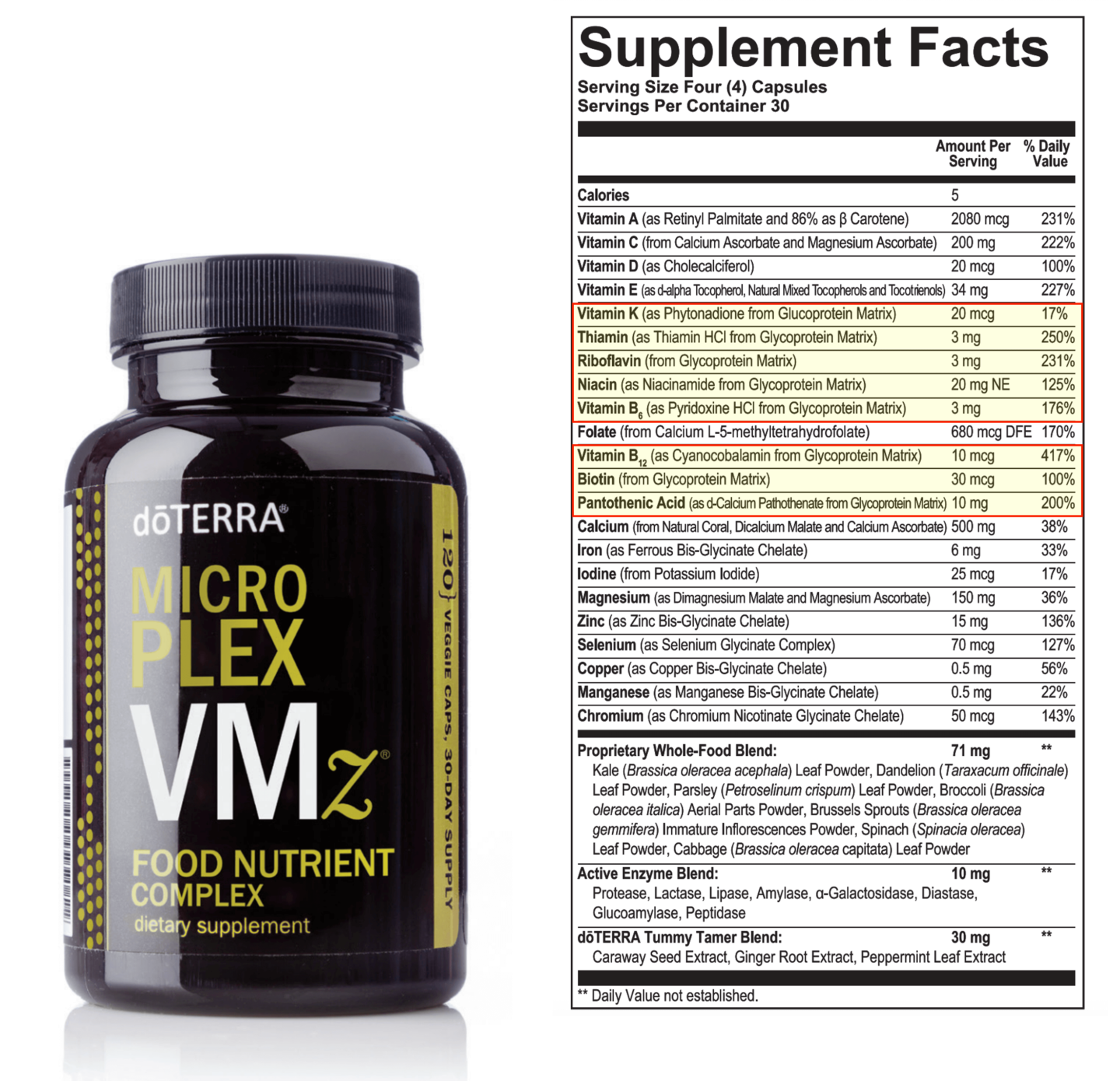There are 13 essential vitamins that our body needs: vitamins A, C, D, E, K, and the B vitamins (thiamine, riboflavin, niacin, pantothenic acid, biotin, B6, B12, and folate)
In supplements, there are a variety of sources and forms of each vitamin.
Are the forms of the vitamin active or does the body need to metabolize and convert it? Are the forms stable and bioavalable and beneficial? Are the vitamins isolates or are they in a form of a complex (vitamin attached to an organic compound)?
Each of the 13 vitamins are different and unique and must be individually evaluated to choose the best source, form, and method of delivery for each.
Vitamins are divided into two groups:
- Water soluble vitamins: Vitamin C and B Vitamins (thiamine, riboflavin, niacin, panthothenic acid, biotin, B6, B12, and folate) are water soluble vitamins
- Fat soluble vitamins: Vitamin A, Vitamin D, Vitamin E, and Vitamin K
Water-soluble vitamins are vitamins that are dissolved in water and readily absorbed into tissues for immediate use. Because they are not stored in the body, they need to be replenished regularly in our diet or through supplementation.
The issue with water-soluble vitamins like B-complex vitamins is that it is quickly excreted if it isn’t used by the body. This is a major issue with vitamin isolates commonly used in supplements.
Fermented Vitamins (Glycoprotein Matrix Vitamins)
Taking vitamins are wasteful if you aren’t able to absorb and utilize most of it. Scientists have been developing and refining methods to improve absorption and bioavailability for decades. Fermentation is a method used to improve the bioavailability and absorption of nutrients. This greatly improves the bioavailability of water-soluble vitamins like the B Vitamins.
Different companies label fermented vitamins differently
- New Chapter uses the term “from fermented media” on their supplement labels
- Garden of Life uses the term “from culture of Saccharomyces cerevisiae” on their labels
- dōTERRA uses the term “as glycoprotein matrix” on their labels
Different companies market fermented vitamins differently
- New Chapter markets their fermented vitamins as “fermented vitamins”
- “patented fermentation technology to enrobe each premium vitamin and mineral in a transformative superbroth of organic Saccharomyces yeast and organic whole foods”
- Garden of Life markets their fermented vitamin as “Raw whole food vitamins”
- “Nobel Prize-winning science inspired this the process we use to “grow” food vitamins”
- dōTERRA markets their fermented vitamin as “patented glycoprotein matrix”
- “To make a vitamin glycoprotein compound, a vitamin is introduced to a culture of lactobacillus and yeast. As it grows, the yeast metabolizes and binds the vitamin into its protein matrix, making the vitamin more recognizable as food in the digestive process.”
The term “fermented” can cause some confusion. While the complex is made through the fermentation process the resulting complex is different than fermented foods and may have different benefits as fermented foods. Don’t expect all the benefits of fermented vitamins as you do for fermented foods.
The term “whole food vitamins” can also cause confusion and is debated. Some people believe that whole food vitamins come from the food and that vitamins that are fermented aren’t technically a whole food at all. Others believe that there is no such thing as a whole food vitamin supplement as whole foods are foods and not pills or tablets.
Technically, the most accurate description is a “glycoprotein matrix” or “vitamin glycoprotein compound” or “glycoprotein matrix bound vitamin.” Glycoprotein matrix are organic compounds from plants and created by yeast or probiotics through the fermentation process. It’s resulting structure is like food. However, the term glycoprotein matrix is not very friendly.
In this article I’ll use the term fermented vitamin to describe the food complex vitamin.
How are fermented vitamins made?
For me, it’s important to know how fermented vitamins are made. It helps me understand the work and thought process that goes into the vitamin. Different companies have developed various methods using the same principle of fermentation. Fermentation not only creates a food matrix vitamin, but more vitamin B can be created through the fermentation process.
One of the methods to make fermented vitamins was patented in 2001 by Dilip Choksh(US6864231B2, US20020182183A1).
Here is the proccess:
- Yeast (Saccharomyces cerevisiae) is mixed with natural plant carbohydrates.
- Target nutrients (vitamins) are added to the yeast solution.
- Non-GMO soy flour and other ingredients such as hesperidin are added to continued fermentation
- Organic yeast begins to biotransform the vitamin by absorbing the nutrient into its cell structure and break it down.
- Enzymes are added to slow down fermentation and break down the cell walls leaving, destroying the yeast, and leaving only glycoprotein matrix nutrient. Probiotic bacteria (L. acidophilus) are added and low heat is applied to complete the fermentation process leaving a glycoprotein matrix bound nutrient.
This particular patented method by Dilip Choksh is used by Ashland to create glycoprotein matrix (GPM) bound nutrients. Ashland supplies companies such as dōTERRA with fermented vitamins.
Why are fermented B Vitamins (Glycoprotein Matrix Vitamin) better than B Vitamin isolates?
Vitamin isolates are individual molecules whereas fermented vitamins are food matrix (vitamins that are bound to glycoprotein). Vitamins aren’t isolates in nature or in food, they are usually part of the food. The body doesn’t recognize the vitamin isolate as food so a small amount is utilized. In the case of water soluble vitamin isolates, any vitamin not absorbed is excreted.
The body treats fermented vitamin similar to how it treats food. The reason is because fermented vitamins are a food matrix (vitamins that are bound to glycoprotein). The body accepts it. Instead of being quickly excreted when not used, fermented vitamins are released slowly into the body, over time. Fermented vitamins have a slow, sustained release and are gentle on the stomach. Fermented vitamins are more bioavailable versus the comparable USP vitamins.
Conventional vitamins tend to cause stomach upset. It’s normally recommended to take conventional vitamins with food. Fermented vitamins tend not to cause stomach upset because they already contain the food component.
Fermented vitamins are more bioavailable, better absorbed, and gentle on the GI tract.
Which companies carry fermented vitamins?
Fermented vitamins requires a lot of research and is a labor intensive process. Garden of Life, New Chapter, and Ashland are leaders in fermented vitamins.Ashland supplies companies such as dōTERRA with fermented vitamins.
B Vitamins are important for energy metabolism, nerve activity, muscle activity, growth, reproduction, skin, hair, wound healing, blood formation, DNA, and neurotransmitters. There are eight different B vitamins, each with important roles.
Because B Vitamins are water soluble and excreted if not use, it is beneficial to utilize the glycoprotein matrix form of B Vitamins than the isolated form. The glycoprotein matrix form are more bioavailable, better absorbed, and gentle on the GI tract.
In Microplex VMz, the following B vitamins are glycoprotein matrix bound through a fermentation process:
- Vitamin B1 (Thiamin HCl)
- Vitamin B2 (Riboflavin)
- Vitamin B3 (Niacinamide)
- Vitamin B5 (d-Calcium Pahthonate)
- Vitamin B6 (Pyrodixine HCl)
- Vitamin B7 (Biotin)
- Vitamin B12 (Cyanocobalamin)
The following B vitamin is not glycoprotein matrix bound through a fermentation process.
- Vitamin B9 (Folate) (5-MTHF)
The reason Microplex VMz contain 5-MTHF instead of glycoprotein matrix bound folic acid or folate.
Folate is important for DNA synthesis and reproductive health. Deficiency of folate can lead to reduced hemoglobin content in red blood cells, impaired cell maturation and megaloblastic anemia.
In a previous article I wrote about the reasons why 5-MTHF is currently the best form of folate or Vitamin B9. It is the active form of folate that your body can readily use. It greatly benefits people with the MTHFR gene mutation which it is estimated that 60% of Americans have. For this reason, 5-MTHF is used rather than fermented or GPM bound folate.
dōTERRA’s multivitamin Micoplex VMz utilizes the glycoprotein matrix form of vitamin for Vitamin K and all the B vitamins except for folate (thiamine, riboflavin, niacin, panthothenic acid, biotin, B6, and B12)

doTERRA’s multivitamin Microplex VMz provides 22 essential vitamin and minerals. Microplex VMz utilizes the most beneficial form of each vitamin and minerals.
I’ve written what ingredients or forms of nutrients to look for in a multivitamin or supplement in the following articles:
Multivitamin
Water Soluble Vitamins (B Vitamins + Vitamin C)
Fat Soluble Vitamins (Vitamin A, D, E, and K)
Macrominerals (Calcium and Magnesium)





March 11, 2022
Your articles are great! So informative.